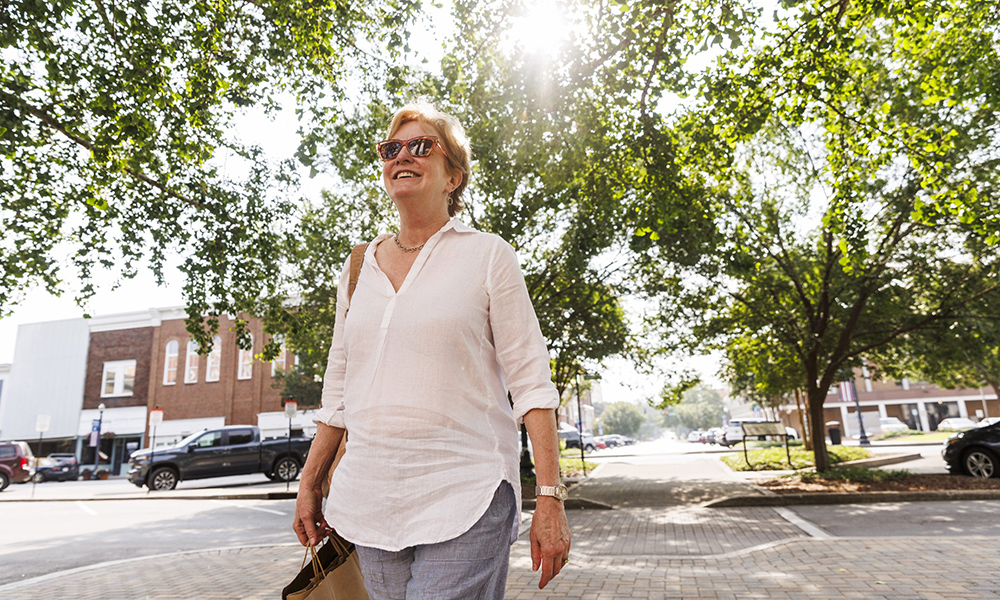
近年来,社交媒体上有不少健步锻炼法。没什么奇怪的,健走确实益处不少,包括降低心脏病发病几率、增强关节和心脏功能、改善情绪,而且可能延长寿命。
最近“日式健走”在TikTok和Instagram上相当流行,一位博主声称,每天仅需30分钟,好处相当于每天走一万步的10倍。
什么是“日式健走”?
这种锻炼方式源自2007年日本一项研究,当时246名参与者被分为三组:不运动、中等强度健走(中等强度步行,每周四天或以上每天至少走8000步),以及高强度间歇健走。
第三组即高强度间歇健走的参与者要先慢走3分钟,然后加速快走3分钟,重复五次或更多,每周四天或以上。研究人员发现,与中等强度健走组相比,高强度间歇健走参与者在力量、耐力和降低血压方面都有明显改善。现在该锻炼方式被称为“日式健走”。
间歇健走的益处
2018年公布了一项长达10年的研究,主要观察对象是长期坚持高强度间歇健走的人们。研究者发现,坚持该锻炼方式的人们腿部力量提升了20%,峰值运动能力提高了40%。
研究人员得出结论,参与者有效抵御了因年龄增长导致的体能衰退。即便有些参与者没能完整坚持10年,健康也有部分改善。
高强度间歇健走过程中心率会升高,所以身体能享受中高强度运动的益处。美国疾病控制与预防中心(Centers for Disease Control and Prevention)建议多数成年人每周进行150分钟中等强度运动,或75分钟高强度运动,间歇健走正是达到目标的理想方式。
此外有研究表明,中高强度运动可能有助于降低早逝风险并提升心肺功能。
入门指南
高强度间歇健走时,心率应该提高到呼吸开始有点急促,但不用尽最大力。研究人员认为强度约为最大心率的70%。
与此同时,较低强度健走应该不费力,能同时跟别人轻松聊天。
两种强度健走交替,每种持续3分钟,一共30分钟。每周练上4次就可以。(财富中文网)
译者:梁宇
审校:夏林
近年来,社交媒体上有不少健步锻炼法。没什么奇怪的,健走确实益处不少,包括降低心脏病发病几率、增强关节和心脏功能、改善情绪,而且可能延长寿命。
最近“日式健走”在TikTok和Instagram上相当流行,一位博主声称,每天仅需30分钟,好处相当于每天走一万步的10倍。
什么是“日式健走”?
这种锻炼方式源自2007年日本一项研究,当时246名参与者被分为三组:不运动、中等强度健走(中等强度步行,每周四天或以上每天至少走8000步),以及高强度间歇健走。
第三组即高强度间歇健走的参与者要先慢走3分钟,然后加速快走3分钟,重复五次或更多,每周四天或以上。研究人员发现,与中等强度健走组相比,高强度间歇健走参与者在力量、耐力和降低血压方面都有明显改善。现在该锻炼方式被称为“日式健走”。
间歇健走的益处
2018年公布了一项长达10年的研究,主要观察对象是长期坚持高强度间歇健走的人们。研究者发现,坚持该锻炼方式的人们腿部力量提升了20%,峰值运动能力提高了40%。
研究人员得出结论,参与者有效抵御了因年龄增长导致的体能衰退。即便有些参与者没能完整坚持10年,健康也有部分改善。
高强度间歇健走过程中心率会升高,所以身体能享受中高强度运动的益处。美国疾病控制与预防中心(Centers for Disease Control and Prevention)建议多数成年人每周进行150分钟中等强度运动,或75分钟高强度运动,间歇健走正是达到目标的理想方式。
此外有研究表明,中高强度运动可能有助于降低早逝风险并提升心肺功能。
入门指南
高强度间歇健走时,心率应该提高到呼吸开始有点急促,但不用尽最大力。研究人员认为强度约为最大心率的70%。
与此同时,较低强度健走应该不费力,能同时跟别人轻松聊天。
两种强度健走交替,每种持续3分钟,一共30分钟。每周练上4次就可以。(财富中文网)
译者:梁宇
审校:夏林
There have been numerous walking workout trends that have circled social media in recent years. It’s no wonder—walking has numerous benefits, including reducing heart disease risk, strengthening your joints and heart, boosting your mood, and potentially helping you live longer.
The latest trend making the rounds across TikTok and Instagram is known as “Japanese walking,” and one creator claims that in just 30 minutes, you’ll get 10 times the benefits of hitting 10,000 steps a day.
What is ‘Japanese walking’?
The workout originates from a 2007 study based in Japan where 246 participants were divided into three groups: no walking, moderate-intensity continuous walking (walking at a moderate effort and taking at least 8,000 steps per day four or more days per week), and high-intensity interval walking.
The third group, doing the high-intensity intervals, were instructed to walk slowly for three minutes, then walk quickly at a hard effort for three minutes, and repeat five or more times for four or more days per week. The researchers discovered that this group experienced noticeable improvements in strength, endurance, and decreased blood pressure, more so than the moderate-intensity continuous walking group. This workout is what’s now become known as “Japanese walking.”
The benefits of interval walking
Another study from 2018 observed participants who did this exact walking workout over the course of 10 years. They found that those who kept up with the workout for the duration of the study experienced a 20% improvement in their leg strength, and a 40% improvement in their peak exercise capacity.
The researchers concluded that those participants had protected against age-associated declines in physical fitness. Even those who weren’t able to maintain the workout for the full 10 years had those improvements partially preserved.
Since you’re getting your heart rate up during the harder walking intervals, your body gets the benefit of more moderate-to-vigorous intensity exercise. The Centers for Disease Control and Prevention recommends 150 minutes of moderate-intensity activity each week for most adults, or 75 minutes of vigorous-intensity activity—and pushing the walking pace every so often could help you reach that target.
Additionally, research shows that moderate-to-vigorous intensity activity is associated with lower risk of early mortality and improved cardiorespiratory fitness.
How to get started
For the higher-intensity intervals, your heart rate should be elevated to the point where you’re just starting to feel out of breath, but not at your maximum effort. The researchers consider this 70% of your max effort capability.
Meanwhile, the lower-intensity walking should be an easy effort, where talking is still comfortable.
Alternate walking at each intensity for three minutes until you reach 30 minutes. Incorporate this workout in your routine four times per week.






